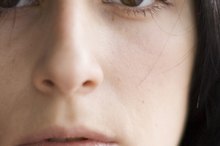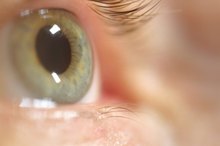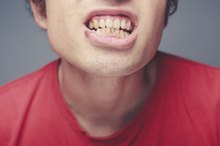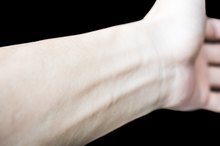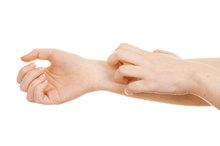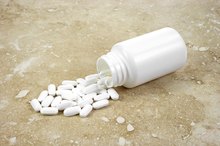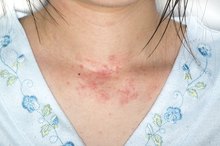What Are the Treatments for Cheilitis?
Cheilitis is an inflammation of the lips, typically causing peeling, cracking and soreness. Angular cheilitis refers specifically to inflammation at the corners of the mouth. Many conditions and factors can precipitate transient or chronic cheilitis, including overexposure to the sun, nutritional deficiencies, allergies, medications, dehydration, diet and certain systemic diseases. Transient cheilitis typically requires no medical intervention. Treatment for chronic cheilitis depends on the underlying cause.
If you are experiencing serious medical symptoms, seek emergency treatment immediately.
Lip Balm
The American Academy of Dermatology explains that the lack of oil glands in the lips leaves the skin vulnerable to transient episodes of drying and inflammation 1. Lip balm protects the lips from the drying effects of the wind, dry air, salty foods, mouth breathing and habitual licking of the lips. Lip balm with sunscreen provides the added benefit of protecting the lips from overexposure to the sun. Lip balm will not resolve chronic forms of cheilitis, however.
- The American Academy of Dermatology explains that the lack of oil glands in the lips leaves the skin vulnerable to transient episodes of drying and inflammation 1.
- Lip balm with sunscreen provides the added benefit of protecting the lips from overexposure to the sun.
Iron Supplementation
Possible Conditions for Chronic Chapped Lips
Learn More
Angular cheilitis may develop as a complication of iron deficiency anemia, notes the New Zealand Dermatological Society 2. In patients with this condition, iron supplementation corrects the underlying anemia, resulting in resolution of the associated angular cheilitis.
Antifungal Ointment
Fungal contamination of skin cracks at the corners of the mouth may contribute to persistent angular cheilitis. In a 2005 article published in the "Journal of Family Practice," Dr. Nadine Skinner and colleagues report that prescription antifungal ointments may aid in the resolution of angular cheilitis 3.
Laser Therapy
What Are the Treatments for Lip Fissures?
Learn More
Chronic sun exposure, such as occurs among people who work outdoors, can lead to inflammatory changes of the lower lip known as actinic or solar cheilitis, reports the New Zealand Dermatological Society on DermNet NZ 4. Actinic cheilitis is a precancerous condition, which may lead to squamous cell carcinoma if left untreated.
Doctors often use laser therapy to destroy the precancerous skin lesions of actinic cheilitis. The Skin Cancer Foundation notes that people taking blood thinners benefit from the absence of bleeding associated with laser treatment compared to surgical intervention 5. Protecting the lips from additional sun exposure with lip balm containing sunscreen or a hat to shade the face helps prevent recurrence of actinic cheilitis.
- Chronic sun exposure, such as occurs among people who work outdoors, can lead to inflammatory changes of the lower lip known as actinic or solar cheilitis, reports the New Zealand Dermatological Society on DermNet NZ 4.
- Doctors often use laser therapy to destroy the precancerous skin lesions of actinic cheilitis.
Topical 5-Fluorouracil
Topical 5-fluorouracil is a chemotherapy medication applied to the lips as a treatment for actinic cheilitis. In a 2008 letter to the editor published in "American Family Physician," Dr. George Larios and colleagues report that topical 5-flurouracil remains a preferred treatment option for patients with several thin lesions associated with actinic cheilitis. This form of treatment avoids potential disfigurement that may result from more aggressive types of therapy.
Related Articles
References
- American Academy of Dermatology: Lip and Mouth Care
- DermNet NZ: Iron Deficiency
- Journal of Family Practice: Clinical Inquiries: What Is Angular Cheilitis and How Is It Treated?
- DermNet NZ: Solar Cheilitis
- Almazrooa SA, Woo SB, Mawardi H, Treister N. Characterization and management of exfoliative cheilitis: a single-center experience. Oral Surg Oral Med Oral Pathol Oral Radiol. 2013;116(6):e485-9. doi:10.1016/j.oooo.2013.08.016
- Rosen A, Ngshanyi S, Tosti A, Schachner L. Allergic contact cheilitis in children and improvement with patch testing. JAAD Case Rep. 2016;3(1):25–28. doi:10.1016/j.jdcr.2016.10.002
- Rosen A, Ngshanyi S, Tosti A, Schachner L. Allergic contact cheilitis in children and improvement with patch testing. JAAD Case Rep. 2016 Dec 26;3(1):25-28. doi: 10.1016/j.jdcr.2016.10.002
- Lugovic-Mihic L, Pilipovic K, Cmaric I, Situm M, Duvancic T. Differential diagnosis of cheilitis - How to classify cheilitis? Acta Clin Croat. 2018;57(2):342-51. doi:10.20471/acc.2018.57.02.16
- Ayesh MH. Angular cheilitis induced by iron deficiency anemia. Cleve Clin J Med. 2018;85(8):581-82. doi:10.3949/ccjm.85a.17109
- Mowad C. Cheilitis. In: UpToDate, Fowler J (Ed). UpToDate, Waltham, MA. (Updated 2019).
- Lai M, Pampena R, Cornacchia L, Pellacani G, Peris K, Longo C. Treatments of actinic cheilitis: a systematic review of the literature. J Am Acad Dermatol. 2019 Aug 7. doi:10.1016/j.jaad.2019.07.106
- Miest R, Bruce A, Rogers RS. Orofacial granulomatosis. Clin Dermatol. 2016;34(4):505-13. doi:10.1016/j.clindermatol.2016.02.024
- American Osteopathic College of Dermatology. Angular cheilitis.
- DermNet NZ. All about the skin.
Writer Bio
Dr. Tina M. St. John owns and operates a health communications and consulting firm. She is also an accomplished medical writer and editor, and was formerly a senior medical officer with the U.S. Centers for Disease Control and Prevention. St. John holds an M.D. from Emory University School of Medicine.

